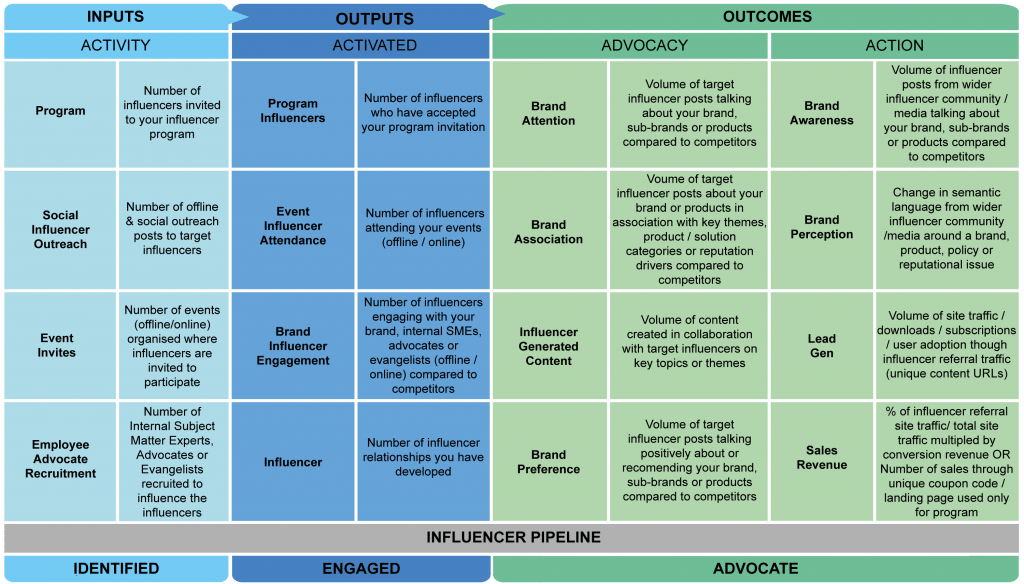Measuring the success and ROI (return on investment) of marketing in general has been notoriously difficult. The whole point of marketing is to evoke action in your target audience. The very reason influencer marketing is so successful, is that we’re all naturally accustomed to being a brand sceptic; word-of-mouth remains the most successful form of marketing. An example: someone seeing your marketing, whether it’s a blog post, a sponsored post or a page in a magazine, then they tell their peers about your brand and products. But how can you measure this? How can you measure what people are doing offline in person? In addition to this we have the newly coined concept of dark social – how can you measure something being shared in private chats on LinkedIn, Facebook, Twitter or email?
More specifically to influencer marketing – how can you measure the return on a relationship? Gary Vaynerchuk articulates this very succinctly in saying: “What is the ROI of your mother?”. While it may not be easy to quantify, you can highlight that the way you’ve been brought up, and the principles you’ve been taught have made you who you are today and guided your career; she may have taught you the basics in life to facilitate your independence at university, enabling you to graduate with a degree.
Measuring the success of an influencer program seems to vary in priority from brand to brand and from role to role. The individuals that are more involved in the program are better able to understand the qualitative successes. These would include an increase in positive brand awareness across the industry, or the vanity metrics of shares and impressions – AKA the outputs. However, because of this they may not be as good at measuring and presenting their quantitative successes. On the other hand senior management may not be as closely involved in the day-to-day running of an influencer program, but it is imperative to them that influencer marketing contributes to the wider business objectives, such as an increase in market share or sales – AKA the outcomes.
In order for you to effectively measure the success of your influencer program, it is important that you have done the ground work and established your objectives at the beginning. You need to outline at the beginning what success looks like for you, so that you can measure what matters.

“Success in influencer marketing will always be measured by those objectives you hopefully thought out when developing your influencer marketing strategy. Influencer marketing, while having additional intangible benefits above and beyond, must more-and-more be measured by the same metrics one would use to measure paid social media marketing activities. The challenge is in architecting influencer marketing campaigns that allow you to more easily do this.”
Neal Shaffer, Founder, Maximise Social Business
“Thomson Reuters’ focus on ‘influencer marketing’ as an integral part of our global social media strategy shines a spotlight on the movers, shakers and opinion leaders of our clients’ & partners’ industries/markets. Success for us is seeing success for them – the group of influencers we have officially recognized. We are working very hard for these individuals and businesses to understand the value that Thomson Reuters bring to the industry and community by partnering and collaborating with them via online, off-line and event activations. We use various metrics – all of which are automated through Onalytica’s IRM.”
Kelvin Lee, Director – Social Media Marketing, Thomson Reuters
Industry Measurement Framework
The below diagram provides structure and clarity to better enable you to measure your success at each stage of your program. We have differentiated between inputs (activity) , outputs (activated) and outcomes (advocacy and action) , and how these correlate with each stage of the influencer pipeline: 1) identified, 2) engaged and 3) advocate.
Qualitative VS Quantitative results
To deliver results to your managers, it’s important to understand where quantitative or qualitative results are important, depending on your end goal.
When measuring brand affinity and brand perception, qualitative metrics are extremely important. Here we’re talking about opinions and people, which is very difficult to quantify. Qualitative metrics are also important when engaging with influential detractors – measuring the reducing level of negativity towards the brand from these influencers (e.g. how has your perception changed? What kind of comments were out there on social media before compared to now?)
On the flip side, if the aim of your influencer program is to amplify your content or increase your share of voice, qualitative metrics aren’t as important, as results are easier to quantify.
“Make sure to develop a program that measures quantitative and qualitative indicators in order to develop a complete influencer marketing strategy with multiple touch points.”
Philip Brown, Head of Influencer Marketing and Brand Advocacy, Come Round
The importance of setting internal milestones
Often, brands get too caught up in measuring just their end goals, and get disheartened when these results seem to be lacking. Your end goals and business objectives will always be the most important, but it is also important to measure and recognise when you hit your milestones along the way. Laying out and measuring these milestones helps you achieve your end goals and keeps motivation and impetus high.
Starting an influencer program requires integration of your teams’ skill sets, as well as integrating your influencer marketing strategy into your existing marketing and communications strategies.
Setting goals around this internal integration can help you maintain focus and achieve maximum results from your program. For example:
- Unlocking access to senior execs
- Integrating skill sets outside of your team such as content and design resources
- Recruiting additional internal subject matter experts to participate in the program
- Access to new and interesting content
- Editorial rights to use a specific social handle
- Getting program buy in from senior management
Influencer marketing is a new concept compared to PR – so it is extremely important to evangelise internally. An example of this is sharing your success stories – this will help to drive visibility internally and open up opportunities for further investment in: time, money and resource for your team and maybe even others. Other employees will also see the benefit of being on social themselves. This is even more important if your team are the first to start an influencer program.
“It is important to document success and create a playbook internally to evangelize the program and show best practice.”
Jamin Spitzer, Global Director of Communication Insights, Microsoft
Measuring your inputs
Your inputs are the activities that your team are completing in the identification phase: social influencer outreach, inviting influencers to join your program, inviting influencers to events, getting internal employees on board to advocate and evangelise. Getting this stage right requires really understanding what social channels your target audience and influencers are active on.
Put simply, this is measuring the level of activity and effort your teams are inputting in to the program. This is an extremely important first step to measuring your success. If you do well, you can look back at your inputs and duplicate on future programs. Equally, if your program doesn’t do so well, then perhaps you need to increase initial input activity.
Measuring your outputs
Your outputs are the number of your activities that have converted into activated and engaged influencers. Here, your engagement strategy really comes in to play. Out of the program invites, event invites, social outreach and internal evangelism – how much of this has converted:
- How many influencers have joined the program?
- How many have attended your events?
- How many relationships have been built?
- How many influencers have engaged with your brand?
Measuring your outcomes
Outcomes should link to your wider business objectives and end goals. Your outcomes are the actions being taken from both your target audience and your influencers now advocating your brand:
- How many influencers are posting about your brand?
- How many influencer collaborations have you done?
- How many influencers are talking positively about your brand compared to before?
- How has this increase in influencer advocacy affected your wider/target audience’s actions – are your influencers’ influencers now talking about your brand?
- How has your brand perception changed?
- Have you seen an increase in web traffic, enquiries and sales?
Influencer marketing can either be a stand-alone alternative activity to PPC or complementary – i.e. amplifying exposure of influencer generated content. With this said, it is important to ensure there is some like-for-like comparison.
Quantitative indicators:
- Are you reaching your target audience – according to location, demographic, views and engagement? If you’re not, then perhaps you need to revisit the work you did around influencer identification, and your activity inputs.
- What is the Cost-Per-Click, Cost-Per-Thousand or Cost-Per-Action? How does this compare to your PPC costs? If using PPC as an amplifier, have you seen higher click through rates?
“Buying an influencer’s reach can sometimes be more expensive than the equivalent advertising reach, but judging influencer costs on that metric alone ignores many other benefits.”
Tim McLoughlin, Head of Social Media, Hotels.com
Qualitative Perception:
- How your brand share of voice has changed compared to your competitors
- Brand association
- Key message delivery
Having either too much of a short term view or too much of a long term view can be detrimental to motivation and success. You need to aim for the long term goals by focusing on the short term- this helps keep focus and drive.

“The currency of B2B influencer marketing is always the same: credibility.”
Luke Brynley-Jones, CEO, OST Marketing
Short term view/first 3-6 months:
- Positive brand references and mentions
- Increased brand consideration and preference over competitors
Long term view:
- Increased 2 way relationships between your brand and influencers
- A strong army of brand advocates waiting to come to your rescue
“Accountability of your content has to map the behaviours you want to influence. Map personas against what you expect to happen on the campaign.”
Lee Odden, CEO, TopRank Marketing
To download the full white paper, click the button below.

DOWNLOAD NOW!
TAGS
DEFINITIVE PRACTICAL GUIDE TO INFLUENCER RELATIONSHIP MANAGEMENT
Download this free white paper including guidance and frameworks, that takes you through the whole influencer marketing process, in a practical and actionable way.






